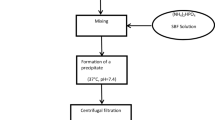Abstract
Poly(є-caprolactone) (PCL 6, 12 and 24 wt%) and zirconium (ZrO2) organic–inorganic hybrid materials have been synthesized by the sol–gel method from a multicomponent solution containing zirconium propoxide [Zr(OC2H7)4], poly(ε-caprolactone) (PCL), water, chloroform (CHCl3). Sodium ampicillin was incorporate in the hybrid materials to verify the effect as local controlled drug delivery system. The structure of interpenetrating network is realized by hydrogen bonds between Zr-OH group (H donator) in the sol–gel intermediate species and carboxylic group (H-acceptor) in the repeating units of the polymer. The presence of hydrogen bonds between organic/inorganic components of the hybrid material was proved by FTIR analysis. The morphology of the hybrid material was studied by scanning electron microscope (SEM). The structure of a molecular level dispersion has been disclosed by atomic force microscope (AFM), pore size distribution and surface measurements. The bioactivity of the synthesized hybrid material has been showed by the formation of a layer of hydroxyapatite on the surface of PCL/ZrO2 samples soaked in a fluid simulating the composition of the human blood plasma. Release kinetics in a simulate body fluid (SBF) have been subsequently investigate. The amount of sodium ampicillin released has been detected by UV–VIS spectroscopy and SEM. The release kinetics seems to occur in more than one stage. HPLC analysis has also been taken to ensure the integrity of ampicillin after the synthetic treatment.














Similar content being viewed by others
References
C. SANCHEZ and F. RIBOT, in Proceedings of the First European Workshop on Hybrid organic–inorganic Materials (Synthesis, Properties, Applications), Bierville-France, (1993).
Hybrid Organic–inorganic Materials edited by L.L KLEIN and C. SANCHEZ Special Issue of J. Sol–Gel Sci. Tech. 5 (1995)
C. SANCHEZ and F. RIBOT, New. J. Chem. 18 (1994) 1007
P. JUDEINSTEIN and C. SANCHEZ, J. Mater. Chem. 6 (1996) 511
L. L HENCH and J. K. WEST, Chem. Rev. 90 (1990) 33
B. M. NOVAK, Adv. Mater. 5 (1993) 422
G. H. HSIUE, J. K. KUO, R. J. JENG, J. I. CHEN, X. L. JIANG, S. MARTURUNKAKUL, J. KUMAR and S. K. TRIPATHY, Chem. Mater. 6 (1994) 884
Y. WEI, J. XU, H. DONG, J. H. DONG, K. Y. QIU and S. A. JANSON-VARNUM, Chem. Mater. 11 (1999) 2023
C. J. BRINKER and G. W. SCHERER, 1989, in Sol–Gel science, the physics and chemistry of Sol–Gel processing (San Diego: Academic Press)
L. C. KLEIN, 1988, in Sol–Gel technology (Park Ridge NJ: Noyes PublicaZrons)
I. A. DAVID and G. W. SCHERER, Chem. Mater. 7 (1995) 195
J. J. FITZGERALD, C. J. T. LANDRY and J. M. POCHAN, Macromolecules 25 (1992) 3715
T. SAEGUSA, Macromol. Symp. 98 (1995) 719
M. CATAURO, M. G. RAUCCI, F. DE GAETANO and A. MAROTTA, J. Mater. Sci. 38 (2003) 3102
M. CATAURO, M. G. RAUCCI, F. DE GAETANO, A. BURI, A. MAROTTA and L. AMBROSIO, J. Mater. Sci. 38 (2004) 991
T. KOKUBO, H. -M. KIM and M. KAWASHITA, Biomaterials 24 (2003) 2161
T. KOKUBO, 1999, Boll. Soc. Esp. Ceram.Vid.,in Proceedings of the XVI Int. Cong. on Glass, Madrid, 1992, 1(31-C1), 119
C. OHTSUKI, T. KOKUBO and T. YAMAMURO, J. Non - Cyst. Solids 143 (1992) 84
L. L. HENCH and D. E. CLARK, J. Non-Cryst. Solids 28 (1978) 83
A. PAUL, 1990, in Chemistry of glasses, 2nd edn (London, New York: Chapman and Hall) p. 184
D. S. BANSAL and C. G. PANTANO, Non-Cryst. Solids 115 (1992) 147
M. THOMAS, 1996, in Ultraviolet and Visible Spectroscopy, 2nd edn, edited by D.J. ANDO (England: Wiley) pp. 16–30.
C. SANCHEZ, J. LIVAGE, M. HENRY and F. BABONNEAU, J. Non-Cryst. Solids 100 (1988) 650
E. RADLEIN and G. H. FRISCHOT, J. Non-Crist. Solids 222 (1997) 69
Y. WEI, J. DANLIANG, D. BRENNAN, D. N. RIVERA, Q. ZHUANG, N. J. DI NARDO and K. QIU, Chem. Mater. 10 (1998) 769
Author information
Authors and Affiliations
Corresponding author
Rights and permissions
About this article
Cite this article
Catauro, M., Raucci, M. & Ausanio, G. Sol–gel processing of drug delivery zirconia/polycaprolactone hybrid materials. J Mater Sci: Mater Med 19, 531–540 (2008). https://doi.org/10.1007/s10856-007-3065-y
Received:
Accepted:
Published:
Issue Date:
DOI: https://doi.org/10.1007/s10856-007-3065-y




